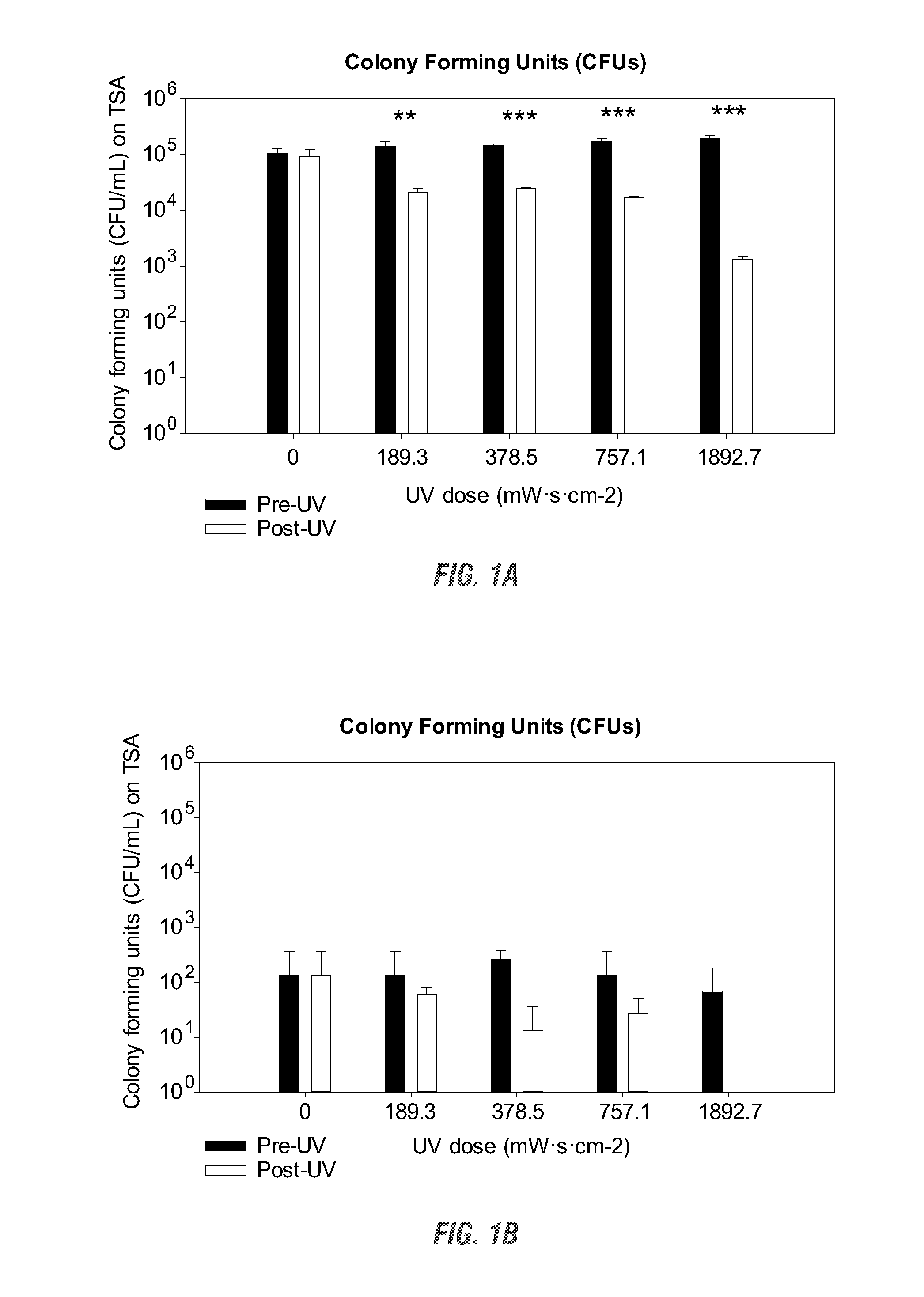Ultraviolet radiation pre-treatment of wastewater, improving its utility for algal cultivation
a technology of ultraviolet radiation and wastewater treatment, applied in biological water/sewage treatment, treatment involving filtration, water treatment water, etc., can solve the problems of affecting the growth of food crops, affecting the growth of algae, and unable to compete with agriculture for nutrients, etc., to increase algae growth, improve algae production and efficiency, and optimize the optical properties of water
- Summary
- Abstract
- Description
- Claims
- Application Information
AI Technical Summary
Benefits of technology
Problems solved by technology
Method used
Image
Examples
example 1
Effect of UV Pre-Treatment Dosing on ADE and PHAE
[0069]Solutions of 5% ADE and PHAE were exposed to a series of increasing UV doses (0, 189.3, 378.5, 757.1, and 1892.7 mW·s·cm−2) in order to elicit physical and chemical changes that may in turn modify algal growth kinetics. To assess the influence of these treatments on the number of viable bacterial competitors and the physiochemical properties associated with each effluent changes in bacteria colony forming units (CFUs), total dissolved phosphorus (TDP), chromophoric dissolved organic matter (CDOM), and absorbance levels were measured.
[0070]Bacterial densities decreased with increasingly higher UV doses for both ADE and PHAE (FIG. 1 A, B) (R2A results were similar, data not shown). There was a 99% and 100% reduction in CFUs for ADE and PHAE respectively using the highest UV fluence (1892.7 mW·s·cm−2). All UV doses (>189.3 mW·s·cm−2) provided a statistically significant reduction in CFUs in the ADE and were linearly correlated with...
example 2
Algal Response to UV-Pretreatment of ADE and PHAE
[0119]The utility of UV radiation to modify ADE and PHAE to better accommodate algal growth was tested through monitoring growth kinetics (growth rate, lag phase, biomass yield). Growth of C. vulgaris as measured through a direct cell count was dramatically modified in UV254 irradiated ADE while PHAE did not show a measurable response (FIG. 5).
[0120]The cultivation of C. vulgaris in ADE resulted in a distinct bimodal growth pattern with a primary and secondary exponential phase separated by a lag phase characterized by a negative growth rate, this phenomena was not seen in the PHAE. This phenomenon may be similar to diauxie that was observed by Monod (1949) in bacteria cultures exposed to two carbon substrates. During diauxie, a primary exponential phase is observed during utilization of the most preferred substrate followed by a minimum or negative growth rate (lag phase) and finally a secondary exponential phase associated with the ...
example 3
[0124]Large scale algae cultivation is both technically and economically challenging. Dairy wastewater is identified as an inexpensive nutrient source that can reduce cultivation costs by replacing fertilizers. Unfortunately, multiple inherent physicochemical properties deem dairy wastewater non-ideal for phototrophic growth. Additional challenges are posed in open systems where algae cultures are highly susceptible to invasive species such as competing algae, bacteria, fungus, and rotifers that are inherently present in wastewaters or may be introduced through prolonged cultivation. These invaders can quickly and easily cause culture crash, particularly in large open systems. Ultraviolet (UV) radiation has been shown to modify dairy wastewater, changing dissolved organic matter (DOM), microbial dynamics, and light attenuation to provide an improved phototrophic growth medium in batch cultures. UV pre-treatment has more recently been found to play a key ...
PUM
 Login to View More
Login to View More Abstract
Description
Claims
Application Information
 Login to View More
Login to View More - R&D
- Intellectual Property
- Life Sciences
- Materials
- Tech Scout
- Unparalleled Data Quality
- Higher Quality Content
- 60% Fewer Hallucinations
Browse by: Latest US Patents, China's latest patents, Technical Efficacy Thesaurus, Application Domain, Technology Topic, Popular Technical Reports.
© 2025 PatSnap. All rights reserved.Legal|Privacy policy|Modern Slavery Act Transparency Statement|Sitemap|About US| Contact US: help@patsnap.com



